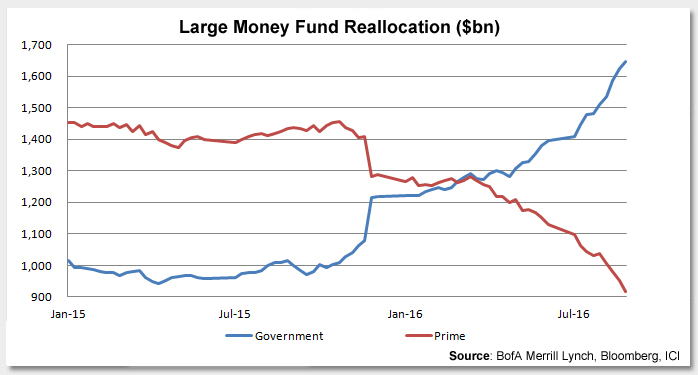The Money Market Fund (MMF) reforms taking effect on October 14 impact approximately $2.7 trillion in money market mutual funds. Prior to the effective date, many prime money market funds are converting to government money market funds.
Prime money market funds are the major short-term funding source for many banks, so the shrinking of prime money market funds will mean higher dollar funding cost for banks. Now, we are seeing higher commercial paper (CP) and LIBOR rates. According to Fitch’s report, the percentage of the commercial paper market that is bought by prime funds has slumped to 19.6% from 30.2%. Commercial paper is an especially important funding source for foreign banks, which are highly dependent on CP to raise dollars to fund their portfolio of dollar assets.
Japanese banks are some of the most dependent on prime MMF’s for U.S. dollar (USD) funding. With less USD funding from prime MMFs, Japanese banks will have to either issue cheaper short-term commercial paper or exchange Japanese yen (JPY) for USD. A powerful financial tool banks can use to raise foreign currency funding is cross currency basis swaps, which are a floating exchange derivative to exchange the interest rate payments and notional amounts in two different currencies. Take Japanese banks for example, they would pay 3 month USD LIBOR and receive the 3 month deposit rates in JPY plus the cross currency basis swaps spread to enter into the trades. We’re seeing 3 month JPY-USD basis swap turning more negative dramatically since June, indicating a rising cost of borrowing USD with JPY. From these market dynamics, lending USD to Japanese counterparties in exchange for JPY becomes attractive.
Key Takeaway:Commercial paper is trading cheap due to the shrinking market of prime MMFs. Lending U.S. dollars to the counterparties which rely heavily on the MMF for dollar funding is attractive.
The material provided here is for informational use only. The views expressed are those of the author, and do not necessarily reflect the views of Penn Mutual Asset Management.
This material is for informational use only. The views expressed are those of the author, and do not necessarily reflect the views of Penn Mutual Asset Management. This material is not intended to be relied upon as a forecast, research or investment advice, and it is not a recommendation, offer or solicitation to buy or sell any securities or to adopt any investment strategy.
Opinions and statements of financial market trends that are based on current market conditions constitute judgment of the author and are subject to change without notice. The information and opinions contained in this material are derived from sources deemed to be reliable but should not be assumed to be accurate or complete. Statements that reflect projections or expectations of future financial or economic performance of the markets may be considered forward-looking statements. Actual results may differ significantly. Any forecasts contained in this material are based on various estimates and assumptions, and there can be no assurance that such estimates or assumptions will prove accurate.
Investing involves risk, including possible loss of principal. Past performance is no guarantee of future results. All information referenced in preparation of this material has been obtained from sources believed to be reliable, but accuracy and completeness are not guaranteed. There is no representation or warranty as to the accuracy of the information and Penn Mutual Asset Management shall have no liability for decisions based upon such information.
High-Yield bonds are subject to greater fluctuations in value and risk of loss of income and principal. Investing in higher yielding, lower rated corporate bonds have a greater risk of price fluctuations and loss of principal and income than U.S. Treasury bonds and bills. Government securities offer a higher degree of safety and are guaranteed as to the timely payment of principal and interest if held to maturity.
All trademarks are the property of their respective owners. This material may not be reproduced in whole or in part in any form, or referred to in any other publication, without express written permission.


